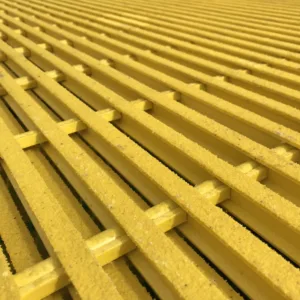Fiberglass grating bars are often used in industrial and construction applications for their strength, durability, and corrosion resistance. They’re made from fiberglass reinforced plastic (FRP), which is a composite material consisting of a polymer matrix reinforced with fibers. The main advantage of fiberglass over traditional materials like steel is its resistance to rust, chemicals, and its non-conductive nature, making it ideal for electrically hazardous environments or where chemical exposure is common.

grating bar fiberglass
Applications of fiberglass grating bars include, but are not limited to:
- Walkways and footbridges in corrosive environments like chemical plants or offshore platforms.
- Covers for drains and ventilation ducts.
- Platforms and stair treads in industrial settings.
- Structures in water treatment facilities.
There are several types of fiberglass grating, including molded and pultruded gratings. Molded grating is made by interweaving continuous strands of fiberglass and using a resin to cure and form a solid sheet, which can then be cut to size. Pultruded grating is made by pulling strands of fiberglass through a die, where they are coated with resin and formed into the shape of the grating bar. Both methods produce gratings that are lightweight, easy to install, and require minimal maintenance.
Technical specifications, installation advice, and purchasing options for fiberglass grating bars can vary widely depending on the manufacturer, the specific application, and the environmental conditions where they will be used. Below is a general guide that covers these aspects:
Technical Specifications
- Material Composition: Made of fiberglass reinforced plastic (FRP), combining resin (often polyester, vinyl ester, or epoxy) with fiberglass strands.
- Load Capacity: Varies based on the thickness and structure of the grating. Specifications should include maximum load capacity and deflection criteria.
- Dimensions: Commonly available in standard panels that can be cut to size. Thickness, mesh size, and panel size can vary.
- Surface Options: Gratings can come with various surface options such as gritted for slip resistance, concave, or smooth.
- Corrosion Resistance: Highly resistant to a wide range of chemicals, with specific resistance depending on the type of resin used.
- Fire Resistance: Classifications and ratings for fire resistance are available for certain types of FRP grating.
- Temperature Tolerance: Able to withstand a wide range of temperatures, but extreme conditions might affect the choice of resin.
Installation Advice
- Cutting: Fiberglass grating can be cut to size using standard power tools equipped with diamond or carbide-tipped blades.
- Fastening: Specialized fasteners and clips designed for FRP grating should be used to secure panels to the supporting structure without compromising the material’s integrity.
- Support: Ensure that the support structure is designed to accommodate the specific load requirements and that the grating is properly supported to prevent deflection.
- Expansion and Contraction: Allow for thermal expansion and contraction in the installation design.
Purchasing Options
- Manufacturers and Distributors: Many companies specialize in FRP products, and it’s best to purchase directly from reputable manufacturers or authorized distributors to ensure product quality and support, like Unicomposite.
- Custom Orders: For specific applications, manufacturers often offer customization options in terms of dimensions, resin type, color, and surface treatment.
- Pricing: Costs can vary significantly based on the specifications and quantity of the order. It’s advisable to obtain quotes from multiple suppliers to compare options.
Additional Tips
- Always refer to the manufacturer’s guidelines for specific installation instructions and safety precautions.
- Consider the environmental impact and sustainability of the materials used.
- When selecting fiberglass grating, take into account the long-term maintenance costs and lifecycle performance.
 info@unicomposite.com
info@unicomposite.com


























